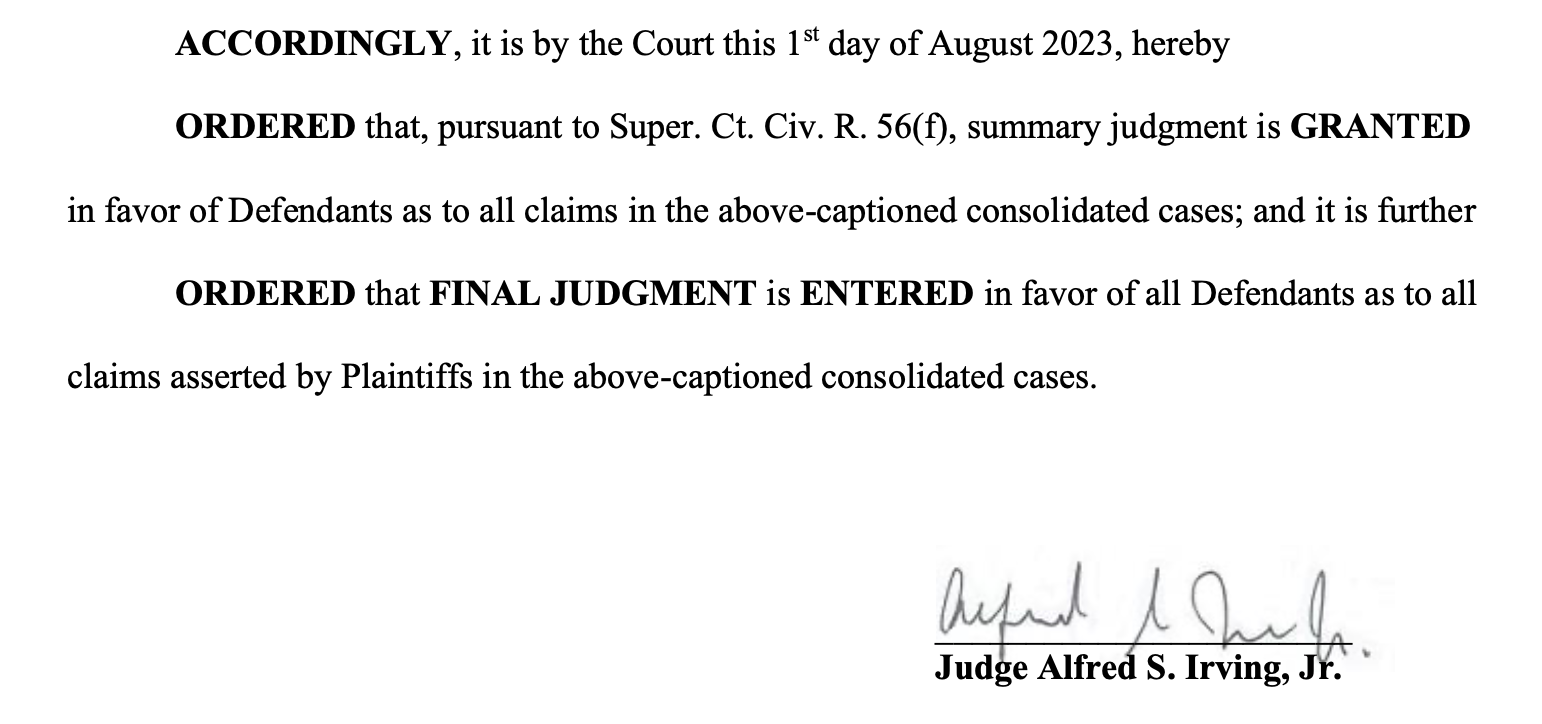All Plaintiff Experts Barred in
Cell Phone Brain Tumor Lawsuits
Twenty-Two Years and Counting
In a big win for the telecoms, and Motorola in particular, a judge has disallowed testimony from the entire slate of expert witnesses who were scheduled to support claims that cell phones can lead to brain tumors.
Judge Alfred Irving Jr. of the Washington DC Superior Court issued the ruling on April 25 in a set of 13 cases collectively known as Murray v Motorola.
The Murray litigation has been going on for a long, long time —think Jarndyce. The original claim was filed more than 20 years ago. In November 2001, Mayer Morganroth and his son Jeffrey Morganroth sued Motorola on behalf of Michael Murray, a 34-year-old technician who had developed a malignant glioma after testing cell phones for Motorola (details in MWN, N/D01).
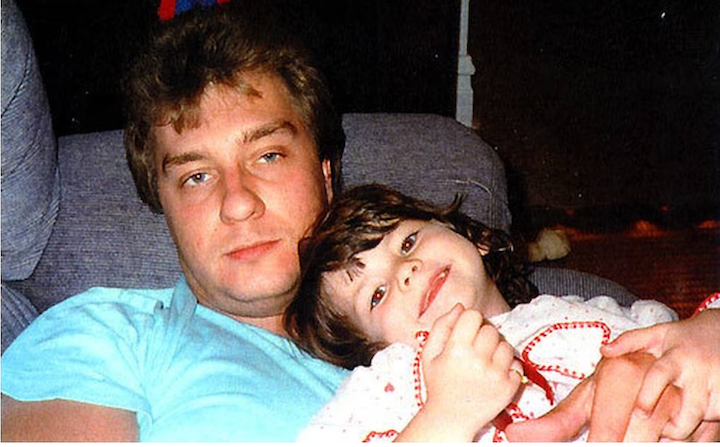 Michael Murray and his daughter Alicia* (photo from Murray family via the Sun-Sentinel)
Michael Murray and his daughter Alicia* (photo from Murray family via the Sun-Sentinel)
Over the next few months, new lawsuits were filed involving other plaintiff firms and corporate defendants. Thirteen of them were combined into Murray, and the Lundy law firm in Louisiana joined the Morganroths as co-counsel.
If past is prologue, there’s much more to come —if only because the stakes are so high. In 2015, the Wall Street Journal estimated that the 13 Murray lawsuits were seeking a combined total of close to $2 billion.
“We will be appealing,” Jeffrey Morganroth told Microwave News from his office near Detroit. “We’re disappointed, but we believe the Court got it wrong as a matter of fact and law in numerous respects.”
“Our experts are world-renowned and preeminent scientists who have dedicated their lives to studying and researching this critical public health issue,” he said.
“This is not the end of cell phone litigation,” Morganroth emphasized. “We are committed to making sure our clients get their day in court.”
Terry Dee of Winston & Strawn in Chicago, who represents Motorola and is the lead counsel for the defense, declined to comment. So did Tom Watson of Watson & Renner in Washington DC, who works for AT&T Wireless. They both referred my questions to CTIA. The wireless industry trade association is another of the many Murray defendants. Watson and Dee have been involved in EMF and RF litigation for decades.
In its statement, CTIA welcomed the decision, calling it “consistent with the views of health experts around the world, including the WHO, the U.S. FDA and the NIH.”
Dee did give Law.com an extensive interview in which he said that Irving’s decision confirms what Motorola has been saying for decades —that “cell phones are safe for consumer use.”
Law.com’s Litigation Daily featured Dee as the litigator of the week for his success in Murray and another cell phone case, Walker v Motorola in Louisiana. (The Lundy firm is representing Frank Walker, who is seeking compensation for his glioblastoma. The case was filed in April 2021; Walker died in December 2020.)
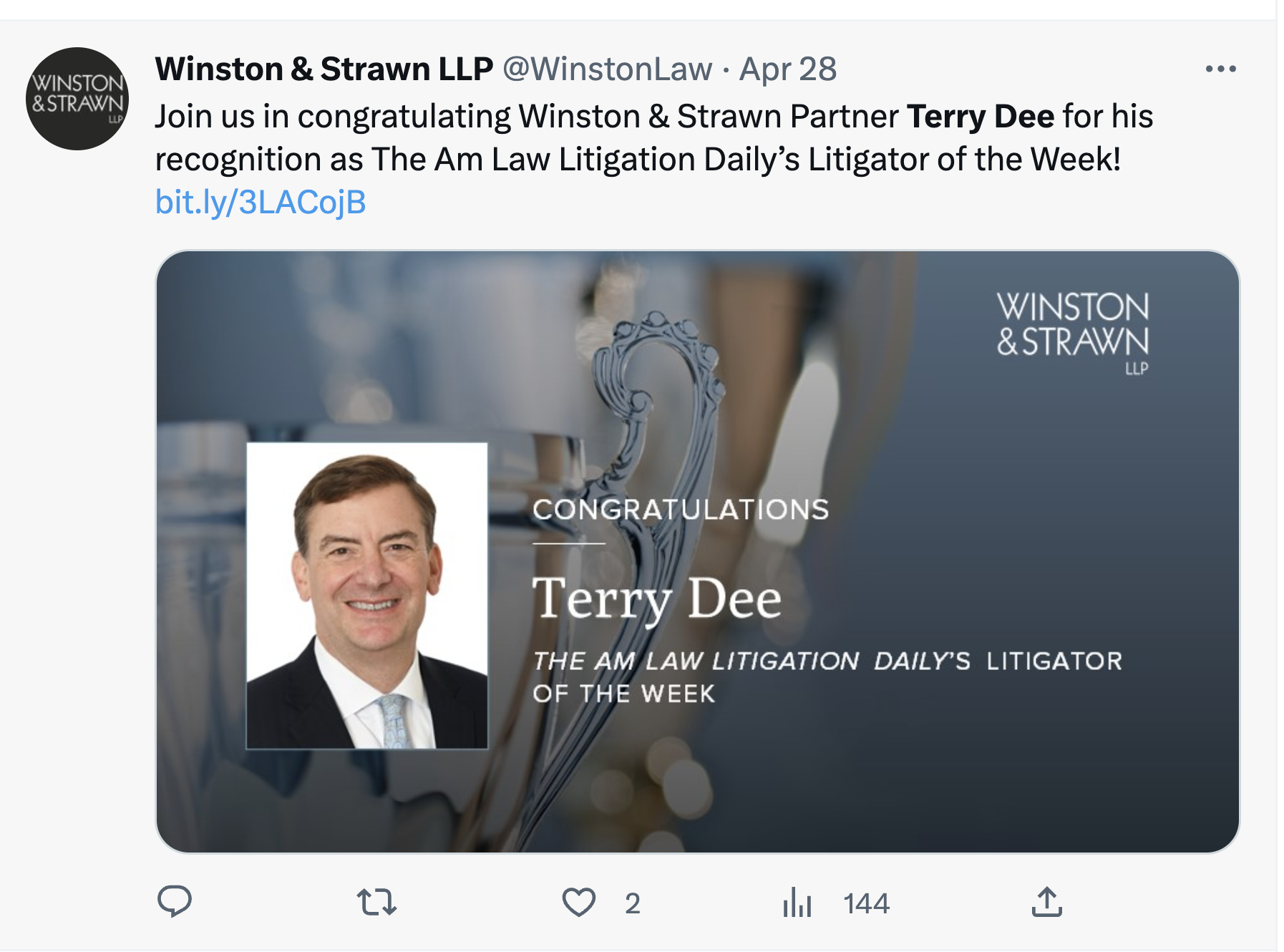 Tweet posted by Winston & Strawn on April 28
Tweet posted by Winston & Strawn on April 28
Motorola is just one of many defendants. They are a who’s who of big telecom, including Apple, AT&T, LG, Motorola, Qualcomm, Samsung and Verizon. Some 40 lawyers are protecting the industry’s interests in the Murray litigation.
Not surprisingly, the plaintiffs are not pleased with the outcome. “Irving’s decision is a serious disservice to public health,” Ellie Marks told me by email. Alan Marks, her husband, developed a brain tumor and also sued Motorola. His claim is one of the 13 lawsuits combined under the Murray umbrella.
All Six Witnesses First Approved, Then Barred
Five of the six disqualified experts are well-known, long-time members of the bioelectromagnetics community. (Plunkett is the exception.) They are:
- Igor Belyaev, biophysicist, Biomedical Research Center, Slovak Republic
- Michael Kundi, epidemiologist, University of Vienna, Austria
- Abraham Liboff, physicist, Oakland University, U.S. (now deceased)
- Wilhelm Mosgöller, biologist, University of Vienna, Austria
- Dimitris Panagopoulos, biophysicist, University of Athens, Greece
- Laura Plunkett, pharmacologist, Integrative Biostrategies, U.S.
Who is allowed to testify and what scientific and medical information they are allowed to bring to a courtroom have been at the center of the Murray litigation for the last decade. (The first decade centered on unsuccessful moves to dismiss the cases.)
In August 2014, the matter appeared to be resolved. After a four-week hearing, the then-presiding judge in Murray, Frederick Weisberg, allowed five of the same six plaintiff experts later rejected by Irving to testify. He disqualified Panagopoulos and two others —Shira Kramer, a U.S. epidemiologist, and Gautam “Vini” Khurana, an Australian neurosurgeon.
The defense challenged Weisberg’s decision and the case rose to the DC Court of Appeals. “This is a marathon,” Morganroth told the Wall Street Journal in the fall of 2015, as he and Dee prepared to argue their case before the full complement of six appellate judges. Morganroth had the right metaphor: That was more than seven years before Irving’s April ruling.
It was another year before the appeals court issued a decision. When it came, the rules of engagement changed. The judges allowed the Murray cases to continue, but the Superior Court would now have to use a different standard to judge scientific evidence. In the parlance, the standard changed from Frye to Daubert (more about that in a moment). The dispute about those same six experts started afresh, except that by this time everyone knew each other.
Judges rotate on and off a given proceeding in the DC Court, but not on any specific schedule. In August 2018, Anita Josey-Herring replaced Weisberg, and she in turn was replaced by Jennifer Anderson for a short stint in 2020. Alfred Irving took over in January 2021.
First, there were new rules, then there were new judges.
A New Round of Reports
Following the decision from the Court of Appeals, the six experts wrote a new round of reports to frame the scientific evidence in the context of the Daubert standard rather the original Frye.
Together, these “supplemental” reports run well over 500 pages. The defense wanted large chunks to be deleted. Many of the objections were about when the papers cited by the experts had been published rather the science itself —though there were plenty of arguments about the science too.
Defense lawyers complained that the plaintiffs had introduced studies published before 2013, which they could have included in the Frye round of evidence gathering, but had not. They asked for 100s of papers to be stricken from the record, including about 150 from Belyaev’s alone (see table below).
 Defense Memorandum in Support of Motion to Strike Unauthorized Portions of Supplemental Expert Reports, Filed September 1, 2017, p.4
Defense Memorandum in Support of Motion to Strike Unauthorized Portions of Supplemental Expert Reports, Filed September 1, 2017, p.4
None of this came cheap. Most of the experts billed at rates in the $300-$400/hour range, though one working for the defense got $650/hour.
Judges as Gatekeepers of Approved Science
A 1993 decision by the U.S. Supreme Court set out new rules for evaluating the reliability of scientific information. The case was Daubert v Merrell Dow Pharmaceuticals, which involved an anti-nausea drug said to cause birth defects (more here). Those rules replaced the criteria codified in a 1923 decision on the reliability of lie detectors —Frye v United States— from the DC Court of Appeals, the same court that ruled in Murray in 2016.
In that 2016 decision to apply Daubert to Murray, the Court of Appeals echoed the call from the Supreme Court that the trial judge must “ensure that any and all scientific testimony or evidence admitted is not only relevant, but reliable.” While Frye would allow evidence if the science is based on a “generally accepted” methodology, under Daubert, the judge has greater discretion to accept or refuse it.
The presiding judge, in effect, serves as a gatekeeper for scientific evidence.† “Properly performing the gatekeeping function will require a delicate touch,” the appellate judges advised.
Judge Josey-Herring responded to the defense motion to delete large sections of the Daubert reports in full gatekeeper mode. She wrote a 61-page order —the specificity of her instructions, at least for me, a non-lawyer, is breathtaking. Here are two examples of her parsing Kundi’s supplemental report:
“Consequently, Defendants’ request to strike Study #11, #17, #21 and #22 is granted to the extent that Dr. Kundi relied on these studies to opine about dose-response in epidemiology.” [p.19]
“Therefore, the Court will grant Defendants’ request to strike the section of Dr. Kundi’s report regarding cofounding [sic] on the grounds that (1) Plaintiffs failed to adequately demonstrate that the change in the evidentiary standard necessitated the inclusion of Dr. Kundi’s cofounding [sic] opinion; and (2) Dr. Kundi only supported this section of his report with a single brief citation to a study from 1958, a date preceding that of his original expert report.” [p.22]
Josey-Herring ends with seven pages of ordered deletions, most of them approving requests from the defense. Here’s a snippet of some of the detailed edits of Belyaev’s report:
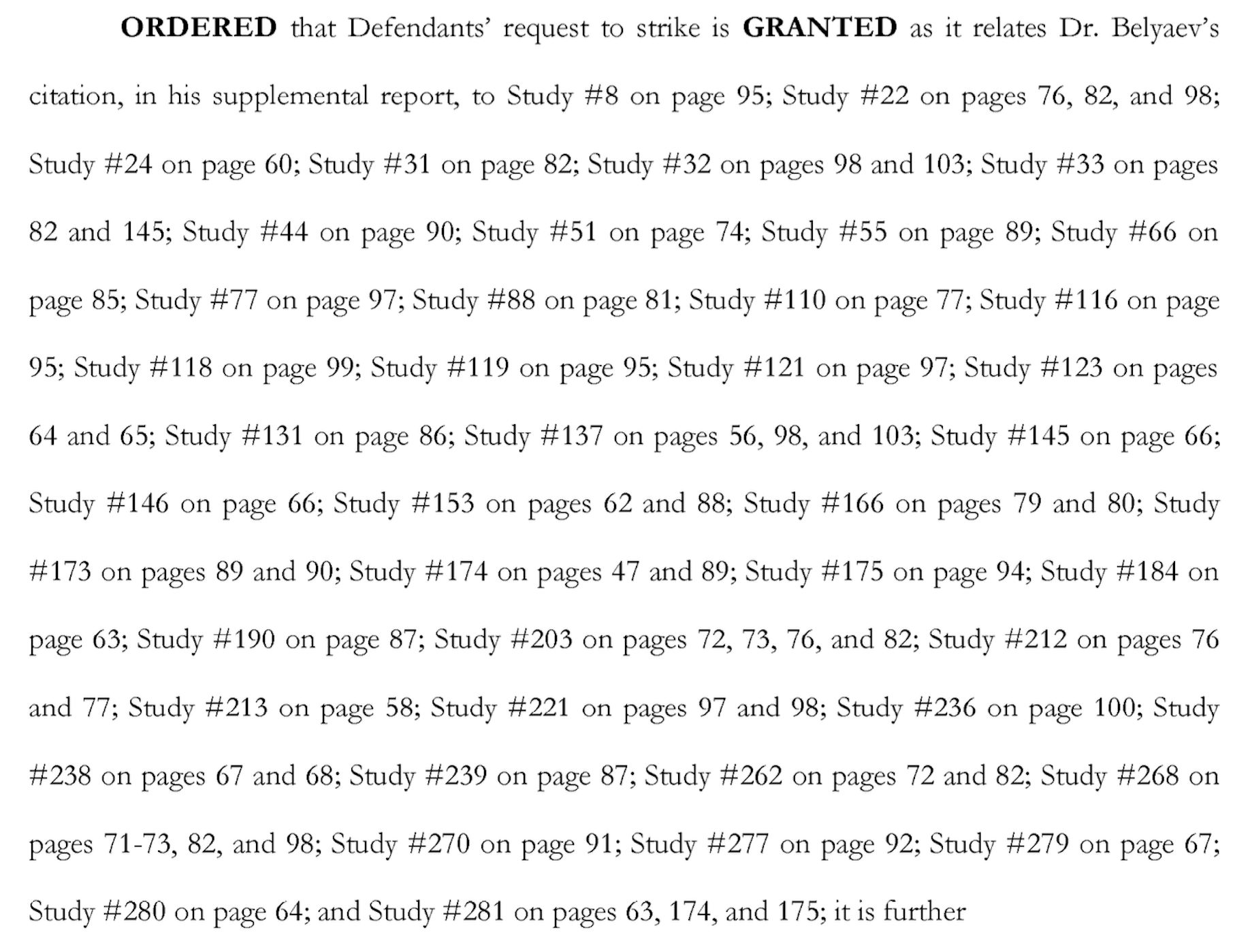 Superseding Amended Order, Judge Anita Josey-Herring, August 28, 2018, p.56
Superseding Amended Order, Judge Anita Josey-Herring, August 28, 2018, p.56
In October 2020, Josey-Herring was designated chief judge on the DC Superior Court.
A Seventh Potential Expert
In July 2019 —even before Josey-Herring issued her order— the defense presented the court with a 100-page memorandum arguing that the experts approved by Weisberg, together with Panagopoulos, should be disqualified. The plaintiffs countered with their own 100-page memo.
Two years later, as they waited for a decision, the plaintiffs filed a 176-page report from a seventh potential expert witness. It was written by Christopher Portier, a former associate director of both the NTP and the NIEHS.
Irving, who had by now taken over the case, refused to allow it on the grounds that it “would disrupt the existing schedule and detrimentally affect the orderliness and efficiency of any trial.”
It would take another two years before Irving issued his ruling barring the other six experts. It came twenty years and five days after Michael Murray succumbed to his brain tumor.
Why Were the Six Disqualified?
Irving’s April 25th decision made the entire Josey-Herring order moot.
Even so, Irving devoted seven pages of his 83-page opinion to her critique of the reports. The next 50 pages explained his own reasoning for barring the experts altogether based on the Daubert standards of evidence.‡
Irving considered each expert in his ruling and decided, one by one, that they didn’t measure up. A common refrain is the “lack of sufficient facts and data” to support their opinions.
Some excerpts:
“In forming his causation opinion, however, Dr. Kundi relies upon studies that suffer from bias, without explaining how he ruled out that bias.” [p.32]
“It does not appear that Dr. Belyaev reliably applied the IARC methodology because he failed to analyze the epidemiology, which he appreciated was the main component that drives the general causation conclusion.” [p.49; note that Belyaev is not an epidemiologist, but he was a member of the IARC committee that evaluated RF–cancer risks in 2011. Portier was also a member of that panel.]
“Dr. Mosgöller’s opinion also suffers from analytical gaps. Specifically, he could not connect his theory of DNA breaks to cancer … [He] does not provide the studies he relied upon to form his opinions, such as the toxicology textbooks he referenced during his testimony.” [pp.57-58]
“The Court appreciates that Dr. Liboff has enjoyed a long scientific career; however…the Court must be able to discern whether he used sufficient facts or data and whether he used reliable principles or methodologies, and whether Dr. Liboff applied the reliable principles and methods to the facts of the case. These requirements cannot be satisfied by an expert indicating he reliably applied an accepted methodology without describing what methods he used and how he applied them. In other words, the analytical gap between the data he used and his proffered opinion is too great.” [pp.67-68]
“Dr. Panagopoulos’s methodology of reviewing other studies is not reliable because he fails to explain how the studies assisted him and whether the studies are reliable.” [p.73]
“The Court does not find Dr. Plunkett’s remaining opinions as a support witness to be relevant now that the Court has excluded plaintiffs’ other experts.” [p.77]
In the same decision, Judge Irving approved testimony from two experts for the defense:
- Meir Stampfer, epidemiologist, Harvard University (U.S.)
- John Laterra, neurologist, Johns Hopkins University (U.S.)
He seemed to be particularly impressed with Stampfer, pointing out that he “has coauthored more than 1,100 scientific articles, many of which are related to cancer epidemiology.” Stampfer is the one who was charging $650/hour back in 2019.
This is the second Daubert hearing on cell phone radiation for both Stampfer and Laterra. The first was in Newman v Motorola, held in federal District Court in Baltimore in February 2002, at about the same time as the 13 cases were combined into Murray. (Microwave News was at the hearing; see our report.) Judge Catherine Blake, like Irving, rejected all the plaintiff experts in Newman (see MWN, S/O02). None of them would later work on Murray.
Two other defense witnesses in Murray also worked on Newman: Mark Israel, a pediatric oncologist, now emeritus, at Dartmouth Medical School, and Christopher Davis, an electrical engineer at the University of Maryland. Davis died after a short illness in early April.
Many More Lawsuits in the Wings
Whatever happens next, the 13 Murray suits are just the tip of the iceberg. In his decision, Irving notes that there are 67 other cases still pending. Six of these were filed “as recently as 2020.”
Many —but not all— will be affected by Irving’s decision. A number of parties agreed to be bound by what happens in Murray, Terry Dee told Law.com, but some have said that they would appeal those stipulations. “I suspect that may be the next battleground before Judge Irving,” he said.
Morganroth said that he has several other experts lined up, but he declined to name them.
How long Irving will remain on the case is not known. He might be rotated off or he may leave the court at the end of the year. His 15-year term ends on December 1; he is seeking reappointment.
Irving was nominated to serve on the DC Superior Court by President George W. Bush in 2008. After graduating from college, Irving joined MCI Telecommunications, first working in accounting and then in network engineering, according to his official biography. He remained with MCI through law school, taking evening classes at Georgetown. Verizon absorbed MCI in 2006 and is a defendant in the case.
Some plaintiffs believe that Irving’s stint at MCI constitutes a conflict of interest and that he should have recused himself from the case a long time ago.
Public comments on Irving’s reappointment are due by May 31.
How Long Has It Been?
In the setup to the interview with Dee, the editors at Law.com joked:
Q: How long-running is Murray?
A: Well, let’s just say that issues around expert witness issues alone have been swirling so long ... that Dee has moved from Kirkland & Ellis to McDermott Will & Emery to Winston in the interim.”
When the case started, Dee was a young associate at Kirkland. He is now a senior partner at Winston.
_________________________
“A Really Lousy Place to Decide Science”
A few days ago, ProPublica and Type Investigations published a story on how courts have handled scientific testimony in cases dealing with lethal injections.
Jules Epstein, a law professor at Temple University states: “A courtroom is a really lousy place to decide science.”
And there’s this from Patrick Schiltz, the chief U.S. district judge for the District Court of Minnesota:
“Sometimes we have really, really hard technical issues. And it is a criticism of Daubert that it asks the judges to do something that judges aren’t particularly well suited to do.”
Schiltz is “the chair of the advisory committee on evidence rules for the Judicial Conference of the United States, the governing body of the federal court system.”
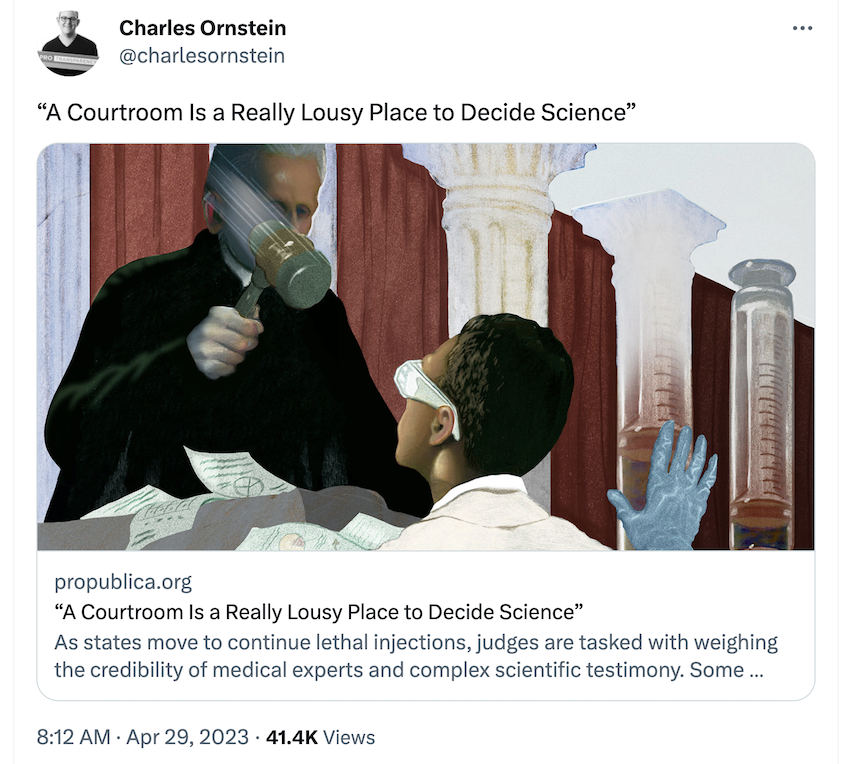
The ProPublica/Type story offers an example of an expert witness being allowed to testify when he likely should not be. The Murray litigation shows this is a two-way street.
Judge Irving Issues Final Judgment
August 31, 2023
On August 1, Judge Alfred Irving issued a final judgment in favor of all the defendants with respect to all claims made by the plaintiffs in Murray v Motorola.
In his order, Irving states that the plaintiffs “have indicated they intend to appeal.”
_________________________
FOOTNOTES
* Last September, Murray’s daughter, Alicia Mitchell, sent out a Tweet when Judge Irving opened his Daubert hearing on scientific evidence: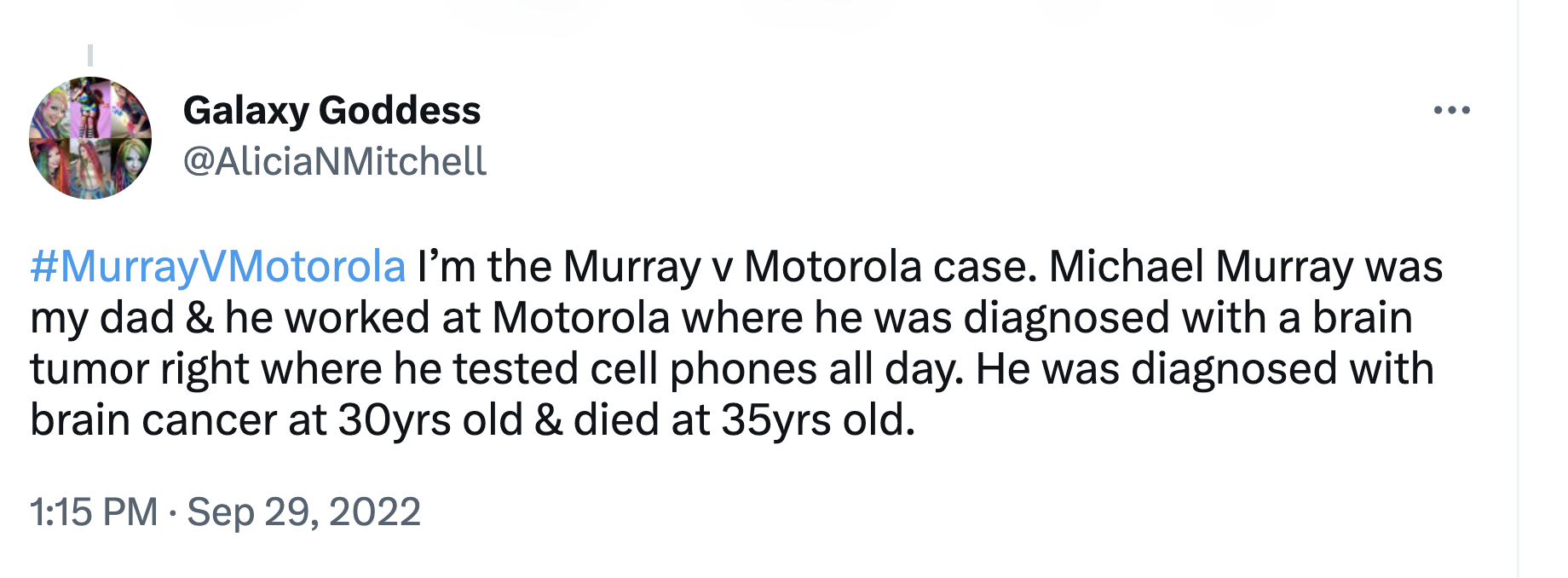
† Here’s a short tutorial on Daubert from the Judicial Gatekeeper Project at Harvard Law School.
‡ On pp.21-22 of his decision, Irving spells out the four standards for evaluating evidence, known as Rule 702:
“A witness who is qualified as an expert by knowledge, skill, experience, training, or education may testify in the form of an opinion or otherwise if:
(a) the expert’s scientific, technical, or other specialized knowledge will help the trier of fact to understand the evidence or to determine a fact in issue;
(b) the testimony is based on sufficient facts or data;
(c) the testimony is the product of reliable principles and methods; and
(d) the expert has reliably applied the principles and methods to the facts of the case.”

